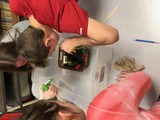
Video Description: Our Earth is a dynamic system with diverse subsystems that interact in complex ways.What are those subsystems and how do they interact?How are these subsystems and the global Earth system changing?What causes these changes?How does NASA monitor these changes?How can Earth system science provide societal benefit?Jessica Taylor, an atmospheric scientist at NASA Langley Research Center, and Dr. Steven Pawson, an Earth scientist from NASA Goddard Space Flight Center, help answer these questions and demonstrate how mathematical modeling helps scientists in their predictions of climate, weather, and natural hazards. Video Length: 5:02.NASA eClips Real World segments (grades 6-8) connect classroom mathematics to 21st Century careers and innovations. They are designed for students to develop an appreciation for mathematics through real-world problem solving.
- Subject:
- Earth Resources
- Earth and Space Systems
- Living Systems and Processes
- Science
- Material Type:
- Visual Media
- Author:
- Betsy McAllister
- Date Added:
- 03/25/2022
